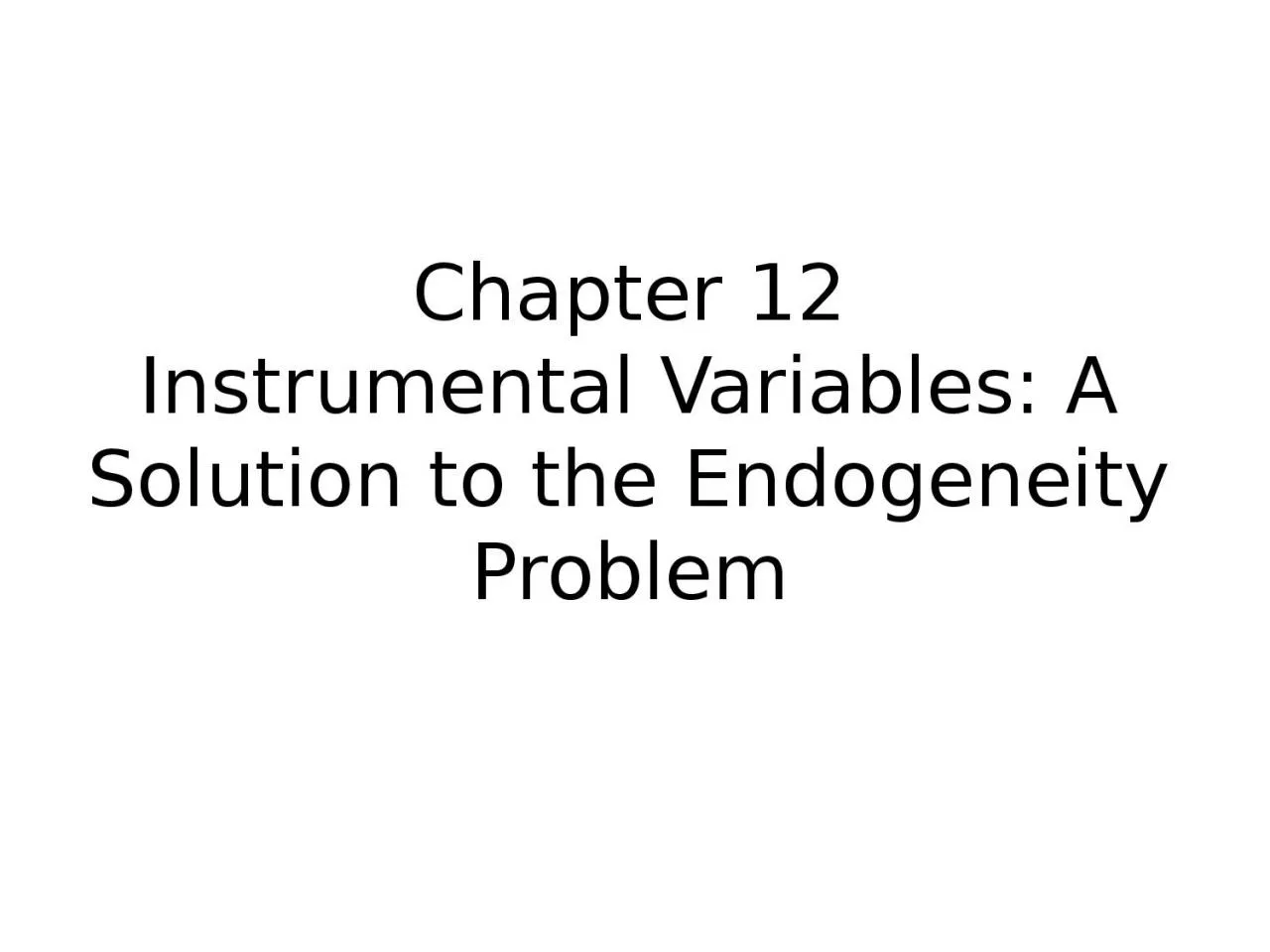

Learning Objectives State the two necessary properties of a good instrumental variable In realworld settings articulate the two properties of a good instrument and critique the instruments used by researchers ID: 1027610
Download Presentation The PPT/PDF document "Chapter 12 Instrumental Variables: A Sol..." is the property of its rightful owner. Permission is granted to download and print the materials on this web site for personal, non-commercial use only, and to display it on your personal computer provided you do not modify the materials and that you retain all copyright notices contained in the materials. By downloading content from our website, you accept the terms of this agreement.
1. Chapter 12Instrumental Variables: A Solution to the Endogeneity Problem
2. Learning ObjectivesState the two necessary properties of a good instrumental variableIn real-world settings, articulate the two properties of a good instrument and critique the instruments used by researchers.Apply the instrumental variables, or two-stage least squares, estimator to solve the endogeneity problem
3. Three Sources of “Endogeneity”Measurement error in X. X and Y determined jointly.Omitted X variable.Some economists use the word “endogeneity” only for jointly determined variables, but modern econometrics uses the word for any of the three settings.
4. Consumption ExampleHousehold consumption in a particular year for 3,254 households in the Dominican RepublicProblem: consumption depends on permanent income not annual incomeSolution: Schooling and experience are instruments for permanent income
5. OLS regressionWhat we wantEndogeneity ProblemGood XBad XYGood XBad XY
6. IV regressionWhat we wantInstrumental VariablesGood XBad XYGood XBad XYZ
7. Characteristics of Good InstrumentsIV1: an instrument must be strongly correlated with the endogenous right-hand-side variable.IV2: an instrument must not be correlated with the error term in the main equation of interest, i.e., an instrument must not cause Yi separately from Xi
8. Consumption ExampleHousehold consumption in a particular year for 3,254 households in the Dominican RepublicProblem: consumption depends on permanent income not annual incomeSolution: Schooling and experience are instruments for permanent income
9. First Stage RegressionVariablePanel A: Without Family SizePanel B: With Family SizeEstimated CoefficientRobustStandard Errort-StatisticEstimated CoefficientRobust Standard Errort-StatisticSchooling0.210.029.490.200.029.23Experience0.0390.0057.160.0280.0055.31Experience-squared-0.000500.00067-7.43-0.000360.00064-5.69Family size 0.110.0112.00Constant10.180.1285.879.960.1284.02Sample size3,2523,252R20.0570.098F-statistic forH0: 1=2=3=050.1843.24
10. Second Stage RegressionVariablePanel A: OLSPanel B: IV MethodEstimated CoefficientStandard Errort-StatisticEstimated CoefficientStandard Errort-StatisticIncome0.350.0124.440.750.0612.14Family size0.140.0120.020.090.019.06Constant7.270.1646.112.930.674.38Sample size3,2523,252R20.34
11. Example: Institutions and Economic Performance
12. Economic DevelopmentDo rich countries have good institutions because they are rich?Or do good institutions make countries rich?Institutions: secure property rights, economic freedom, etc.
13. OLS RegressionIV Regression
14. Example: Schooling and Wages
15. Does schooling increase wages?Individual i in region j in year kSchooling may be endogenous – if only we could randomize schooling …..Use school building program as an instrument
16. Setting for the StudyBetween 1973 and 1978, 61,000 elementary schools were constructed in IndonesiaEnrollment rates increased from 69% to 83%In 1995, Indonesian GDP per capita was 1/30th the size of the US
17. DataCollected from a 1995 survey of men born between 1950 and 1972152,989 individuals in sample60,633 work for a wage in 1995
18.
19.
20. Did building more schools increase schooling and wages?Pj is schools built per 1000 students in region jTi is a dummy variable for whether individual is young in 1974
21. First Stage Regression: Did building more schools increase schooling ?
22. Does Schooling Affect Hourly Wages?
23. Does Schooling Affect Hourly Wages?
24. ConclusionsAdditional 0.12 - 0.19 years of education for each new school built per 1000 children.Additional 1.5% - 2.7% in wages for each new school built per 1000 children.IV: An extra year of schooling implies 6.8% - 10.6% higher earnings.
25. What We LearnedGood instruments must satisfy two conditions in order to convincingly solve the endogeneity problem. IV1: an instrument must be strongly correlated with the endogenous right-hand-side variable. IV2: an instrument must not be correlated with the error term in the main equation of interest.Finding a good instrument is really hard